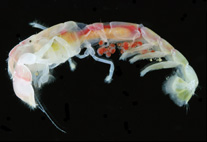Abstract
Alpheus floridanus Kingsley, 1878 has been previously treated as a single, morphologically diverse species with a broad distribution in the eastern and western Atlantic Ocean and eastern Pacific Ocean. However, variations in morphology and color patterns, in addition to genetic evidence, have prompted futher investigation. Morphological characters, including curvature and length of the scaphocerite, number teeth on the incisor process of the mandible, number of pereopodal spines, proportions of the major chela, as well as color patterns, support recognition of several species in the Alpheus floridanus complex. Alpheus floridanus sensu stricto (s.s.) is redescribed based upon a lectotype selected from the former syntypic pair. The mutilated second specimen of the syntypic pair is identified as A. platycheirus Boone, 1927, which is fully redescribed. Three species are described as new: A. hephaestus sp. nov. from the eastern Pacific, and A. roblesi sp. nov. and A. ulalae sp. nov. from the western Atlantic. Morphological comparisions to the eastern Atlantic A. floridanus africanus Balss, 1916 are discussed, however a formal treatment of this subspecies is not the objective of this study. Our proposed taxonomic revisions of the A. floridanus complex are supported in a companion molecular genetic analysis (following paper, this volume).

